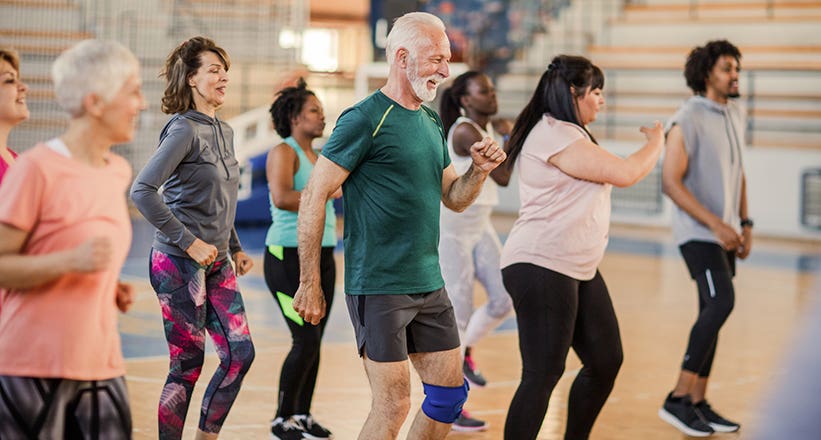Maintaining physical fitness can lower your risk for developing these 9 cancers by 40%
A major study has significantly strengthened the argument that maintaining physical fitness can substantially decrease the risk of cancer.

[Aug. 17, 2023: Staff Writer, The Brighter Side of News]
Jan Ross said: “Since my diagnosis I have had lots of different medications, each with side effects that have been really challenging and affected my quality of life. The myeloma could only be controlled for short periods of time for the first 2 and a half years. Thanks to this amazing new trial drug, after just 7 months the cancer can’t be detected and I only experience relatively minor side-effects like brittle nails and some loss of taste." (CREDIT: Creative Commons)
A groundbreaking study released this week has significantly strengthened the argument that maintaining physical fitness can substantially decrease the risk of cancer.
Published in the revered British Journal of Sports Medicine, this research specifically discovered that young men who had superior cardiorespiratory fitness were less likely to develop multiple types of cancers, including those of the head, neck, lungs, kidneys, and gastrointestinal system.
The study embarked on a comprehensive journey, following over a million young Swedish men for an average span of 33 years. The initial touchpoint was a mandatory military fitness assessment that these men undertook at about 18 years old, a requirement until 2010.
Researchers meticulously documented and subsequently analyzed the rate of cancer diagnoses amongst these participants and aligned them against the fitness levels recorded during their military tests. This wasn’t a subjective gauge; it involved a methodological procedure where participants had to pedal a stationary bicycle. They began at a basic resistance level for five minutes, which then increased by 25 watts every minute until they reached exhaustion.
Related Stories
Study Findings
Upon assessment, the study's authors categorized the participants based on their cardiorespiratory fitness levels—essentially a measure of how efficiently the cardiovascular and respiratory systems can supply oxygen to the muscles.
The revelations were startling:
Individuals with high fitness levels exhibited a 19% reduced risk of head and neck cancers and a 20% reduced risk of kidney cancers, compared to their low-fitness counterparts.
The chance of contracting lung cancer plummeted by 42% for the fittest group. However, this was mainly attributed to their non-smoking habits.
Dr. Aron Onerup, the study's lead author from the University of Gothenburg in Sweden, conveyed, “The risk of cancer seems to continually decrease as participants’ fitness levels ascend.” He further emphasized, “But you don’t have to reach the top, elite athlete level to have a lower risk. An increase in fitness seems to be associated with a reduced risk of developing most of these cancers.”
The hazard of developing malignant skin cancer was linearly associated with CRF, with those having high CRF having the highest risk. The sensitivity analysis for smoking did not change the estimates. (CREDIT: BMJ)
Onerup expressed his astonishment, especially at the findings concerning gastrointestinal cancers. Those at the peak of their fitness had almost 40% lower risk for cancers in several regions, including the esophagus, liver, bile ducts, and gallbladder, and a 20% lesser risk for cancers in the stomach and colon.
This becomes all the more significant considering the drastic rise in gastrointestinal cancer rates among the younger demographic. As per the American Cancer Society, individuals below 55 represented 20% of all colorectal cancer cases in the U.S. in 2019—a significant jump from 11% in 1995. A 2021 study even suggests that colorectal cancer might be the leading cause of cancer deaths in the U.S. for those between 20 to 49 within the next seven years.
Estimated Cancer Incidence Based on Demographic Changes and Average Annual Percentage Change (AAPC) for the Top 10 Common Cancers. (CREDIT: Jama Network)
Adding to a Wealth of Research
According to Dr. Kathryn Schmitz from the University of Pittsburgh, this research isn't an isolated entity but adds to the “robust lexicon” of studies connecting physical activity with reduced cancer risk.
For instance, a March study spanning over 30 million participants deduced that a mere 11 minutes of daily physical activity could cut down the risk of dying from several cancers. Moreover, a 2016 analysis found reduced risks for 13 out of 26 cancers in those who were more physically active.
Schmitz appreciates the methodological rigor of this new study since it used standardized fitness tests instead of relying on self-reported exercise habits.
Estimated Cancer Deaths Based on Demographic Changes and Average Annual Percentage Change in Death Rates. (CREDIT: Jama Network)
However, there were some unusual findings: increased fitness levels were linked with higher risks of melanoma and prostate cancer. Both Onerup and Schmitz believe this might be because the fitter individuals spend more time outdoors and are more likely to be screened for prostate cancer.
Limitations and Future Directions
Schmitz highlights some limitations: the study’s exclusion of women and the absence of continuous assessment of participants’ lifestyle or fitness levels post the initial test. These gaps could influence the final cancer rates.
Nevertheless, the implications are profound. Schmitz concludes, “This does point us in the direction of wanting to have a higher amount of physical activity in our youth.”
As science continues to unravel the intricate relationships between lifestyle choices and long-term health, one thing becomes abundantly clear: the road to a healthier future may well be paved with consistent exercise.
Note: Materials provided above by The Brighter Side of News. Content may be edited for style and length.
Like these kind of feel good stories? Get the Brighter Side of News' newsletter.



